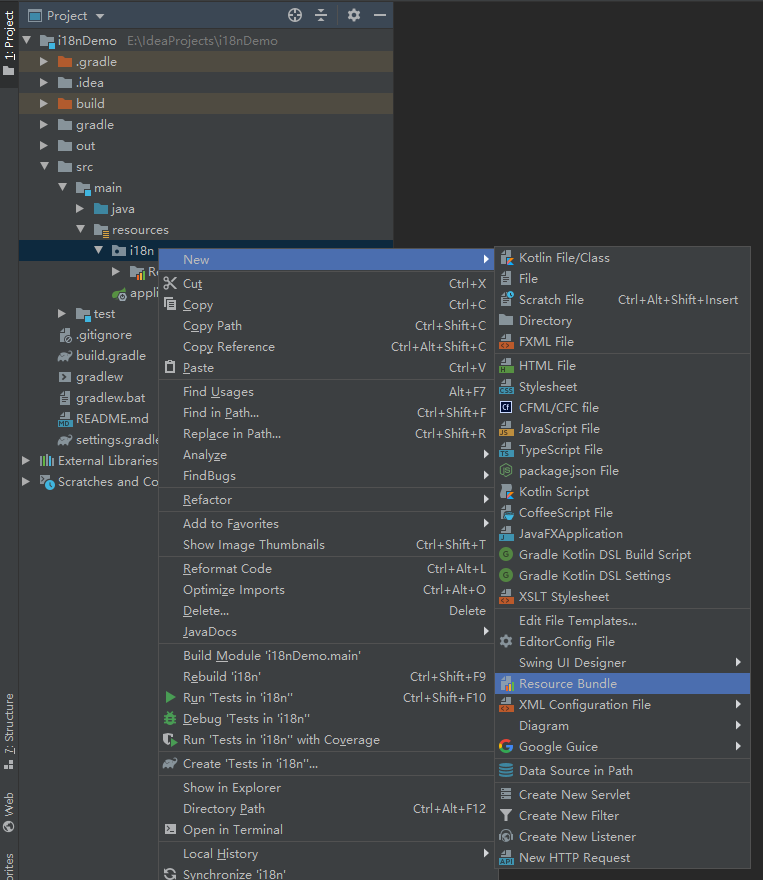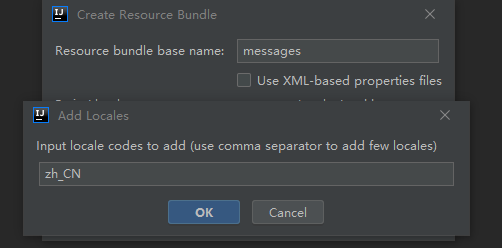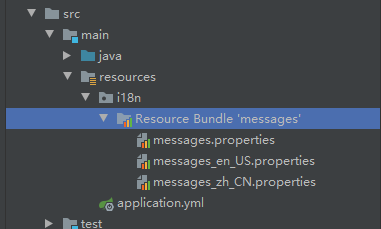最近在研究Spring Boot 的Validator以及国际化,在墙里墙外找了很多很久,可能是因为版本的更新迭代,找到的资料基本都用不了了。自己折腾了半天,终于琢磨出来了,特此记录。觉得过程啰嗦的可以直奔demo代码
本文代码地址:https://github.com/choimroc/SpringBoot_i18nDemo
本文实验的软件环境如下:
- Spring Boot 2.1.8.RELEASE
- JDK 1.8
- IDEA 2019.2.3
- Gradle 5.6.2
1 Validator的使用
Validator的具体用法不是本文的重点,网上也已经有大量的相关文章,所以就不展开说了。这里要提一下的是hibernate-validator包下的注解,在5.0版本之后就已经标记过时(@deprecated)了,hibernate-validator也是建议使用javax.validation 包下的注解来替换,用法都差不多。
2 Validator的配置
在很多文章中都出现过下面的这两种配置(来自hibernate-validator官方文档)
import org.hibernate.validator.HibernateValidator;
import org.hibernate.validator.cfg.ConstraintMapping;
import javax.validation.Validation;
import javax.validation.Validator;
import javax.validation.ValidatorFactory;
//这样
ValidatorFactory validatorFactory = Validation.byProvider(HibernateValidator.class)
.configure()
.failFast(true)
.addMapping((ConstraintMapping) null)
.buildValidatorFactory();
Validator validator = validatorFactory.getValidator();
//或者这样
ValidatorFactory validatorFactory = Validation.byProvider(HibernateValidator.class)
.configure()
.addProperty("hibernate.validator.fail_fast", "true")
.buildValidatorFactory();
Validator validator = validatorFactory.getValidator();
这里说一下failFast的作用,在Validator进行校验时,会校验所有的参数,然后把错误一起返回,如下:
{
"timestamp": 1570029617189,
"status": 500,
"error": "Internal Server Error",
"message": "test.param1: 参数1不能为空, test.param2: 参数2不能为空",
"path": "/test"
}
而设置了failFast之后,如果校验时发现了错误就会停止后续参数的校验。
我们可以看到上面的配置使用的javax.validation包下的Validator,但是在我所使用的Spring Boot版本中,实际使用的是org.springframework.validation包下的Validator,具体可以查看源码里org.springframework.web.servlet.config.annotation.WebMvcConfigurer这个接口的代码。所以上面所用的配置已经不适用了(PS:具体是什么时候替换的我也不清楚,了解情况的同学可以在留言区告知一声,感谢~)。
查看了org.springframework.boot.autoconfigure.validation.ValidationAutoConfiguration,发现defaultValidator用的是org.springframework.validation.beanvalidation.LocalValidatorFactoryBean,但是LocalValidatorFactoryBean下并没有configure和failFast。难道新版本之后就没办法设置了?对比了LocalValidatorFactoryBean和javax.validation后发现LocalValidatorFactoryBean有一个很可疑的属性validationPropertyMap,于是有了下面的配置
@Configuration
@EnableWebMvc
public class WebConfiguration implements WebMvcConfigurer {
@Bean
public LocalValidatorFactoryBean mvcValidator() {
LocalValidatorFactoryBean localValidatorFactoryBean = new LocalValidatorFactoryBean();
localValidatorFactoryBean.getValidationPropertyMap().put("hibernate.validator.fail_fast", "true");
return localValidatorFactoryBean;
}
}
运行之后,发起请求,发现真的起作用了,nice!
注意,如果直接运行会抛出异常信息Consider renaming one of the beans or enabling overriding by setting spring.main.allow-bean-definition-overriding=true,还需要在application.yml或者application.properties中加入如下配置
# yml
spring:
main:
allow-bean-definition-overriding: true
# properties
spring.main.allow-bean-definition-overriding=true
3 Validator的全局异常捕获
上面的返回格式是Spring Boot自带的,而且HttpStatus是500,如果我们想要返回自定义的格式,就得做全局异常捕获。废话不多说,直接上代码:
@RestControllerAdvice
public class GlobalExceptionHandler {
@ResponseStatus(HttpStatus.OK)
@ExceptionHandler(BindException.class)
public Result bindExceptionHandler(final BindException e) {
String message = e.getBindingResult().getAllErrors().stream().map(DefaultMessageSourceResolvable::getDefaultMessage).collect(Collectors.joining());
return new Result(500, message);
}
@ResponseStatus(HttpStatus.OK)
@ExceptionHandler(MethodArgumentNotValidException.class)
public Result handler(final MethodArgumentNotValidException e) {
String message = e.getBindingResult().getAllErrors().stream().map(DefaultMessageSourceResolvable::getDefaultMessage).collect(Collectors.joining());
return new Result(500, message);
}
@ResponseStatus(HttpStatus.OK)
@ExceptionHandler(ConstraintViolationException.class)
public Result handler(final ConstraintViolationException e) {
String message = e.getConstraintViolations().stream().map(ConstraintViolation::getMessage).collect(Collectors.joining());
return new Result(500, message);
}
}
返回的数据如下:
{
"code": 500,
"msg": "参数1不能为空"
}
4 Validator和国际化
直奔主题,常规的配置如下:
@Configuration
@EnableWebMvc
public class WebConfiguration implements WebMvcConfigurer {
public WebConfiguration() {
}
/*国际化 start*/
@Bean
public LocaleChangeInterceptor localeChangeInterceptor() {
LocaleChangeInterceptor localeChangeInterceptor = new LocaleChangeInterceptor();
//自定义参数
localeChangeInterceptor.setParamName("language");
return localeChangeInterceptor;
}
@Bean
public LocaleResolver localeResolver() {
SessionLocaleResolver localeResolver = new SessionLocaleResolver();
//指定默认语言为中文
localeResolver.setDefaultLocale(Locale.SIMPLIFIED_CHINESE);
return localeResolver;
}
@Bean
public LocalValidatorFactoryBean mvcValidator() {
LocalValidatorFactoryBean localValidatorFactoryBean = new LocalValidatorFactoryBean();
localValidatorFactoryBean.getValidationPropertyMap().put("hibernate.validator.fail_fast", "true");
//为Validator配置国际化
localValidatorFactoryBean.setValidationMessageSource(resourceBundleMessageSource());
return localValidatorFactoryBean;
}
@Bean(name = "messageSource")
public ResourceBundleMessageSource resourceBundleMessageSource() {
ResourceBundleMessageSource resourceBundleMessageSource = new ResourceBundleMessageSource();
//指定国际化的Resource Bundle地址
resourceBundleMessageSource.setBasename("i18n/messages");
//指定国际化的默认编码
resourceBundleMessageSource.setDefaultEncoding("UTF-8");
return resourceBundleMessageSource;
}
@Override
public void addInterceptors(InterceptorRegistry registry) {
registry.addInterceptor(localeChangeInterceptor());
}
/*国际化 end*/
}
这样就能完成国际化了,是不是 so easy?!但是这样写有一个问题,就是language参数必须是url参数,如http://localhost:8080/test?language=en_US,一般对于这种公共的参数,我们都希望放在Headers中的,那有没有办法呢?
我们首先来查看一下org.springframework.web.servlet.i18n.LocaleChangeInterceptor这个类的源码,这里面有一个关键的方法preHandle:
//这里只贴出关键代码,有兴趣的可以自己去研究
public class LocaleChangeInterceptor extends HandlerInterceptorAdapter {
……
@Override
public boolean preHandle(HttpServletRequest request, HttpServletResponse response, Object handler)
throws ServletException {
//正是这一行代码,导致只能通过url参数传递language
String newLocale = request.getParameter(getParamName());
if (newLocale != null) {
if (checkHttpMethod(request.getMethod())) {
LocaleResolver localeResolver = RequestContextUtils.getLocaleResolver(request);
if (localeResolver == null) {
throw new IllegalStateException(
"No LocaleResolver found: not in a DispatcherServlet request?");
}
try {
localeResolver.setLocale(request, response, parseLocaleValue(newLocale));
}
catch (IllegalArgumentException ex) {
if (isIgnoreInvalidLocale()) {
if (logger.isDebugEnabled()) {
logger.debug("Ignoring invalid locale value [" + newLocale + "]: " + ex.getMessage());
}
}
else {
throw ex;
}
}
}
}
// Proceed in any case.
return true;
}
……
}
既然找到了源头那就好办了,我们只需要继承源码中的这个类,依然画葫芦,重写关键方法就行了;在源码中,有个checkHttpMethod方法是用private标识的,所以我们同样要复制一份:
public class LocaleInterceptor extends LocaleChangeInterceptor {
@Override
public boolean preHandle(HttpServletRequest request, HttpServletResponse response, Object handler) throws ServletException {
//getParameter 改为 getHeader
String newLocale = request.getHeader(getParamName());
if (newLocale != null) {
if (checkHttpMethod(request.getMethod())) {
LocaleResolver localeResolver = RequestContextUtils.getLocaleResolver(request);
if (localeResolver == null) {
throw new IllegalStateException(
"No LocaleResolver found: not in a DispatcherServlet request?");
}
try {
localeResolver.setLocale(request, response, parseLocaleValue(newLocale));
} catch (IllegalArgumentException ex) {
if (isIgnoreInvalidLocale()) {
if (logger.isDebugEnabled()) {
logger.debug("Ignoring invalid locale value [" + newLocale + "]: " + ex.getMessage());
}
} else {
throw ex;
}
}
}
}
// Proceed in any case.
return true;
}
//复制自源码中
private boolean checkHttpMethod(String currentMethod) {
String[] configuredMethods = getHttpMethods();
if (ObjectUtils.isEmpty(configuredMethods)) {
return true;
}
for (String configuredMethod : configuredMethods) {
if (configuredMethod.equalsIgnoreCase(currentMethod)) {
return true;
}
}
return false;
}
}
//修改WebConfiguration
@Configuration
@EnableWebMvc
public class WebConfiguration implements WebMvcConfigurer {
@Bean
public LocaleChangeInterceptor localeChangeInterceptor() {
//改为我们自定义的LocaleInterceptor
LocaleChangeInterceptor localeChangeInterceptor = new LocaleInterceptor();
//指定参数
localeChangeInterceptor.setParamName("language");
return localeChangeInterceptor;
}
}
这才是真正的so easy!同学们,这说明什么问题呀?这说明只要能够充分利用源码,我们就可以只做出些许修改就能达到目的,可谓是四两拨千斤呀!
然后我们再封装一个获取国际化资源的工具类:
import org.springframework.beans.factory.annotation.Autowired;
import org.springframework.context.MessageSource;
import org.springframework.context.i18n.LocaleContextHolder;
import org.springframework.stereotype.Component;
import java.util.Locale;
@Component
public class LocaleMessage {
private final MessageSource messageSource;
@Autowired
public LocaleMessage(MessageSource messageSource) {
this.messageSource = messageSource;
}
public String getMessage(String code) {
return getMessage(code, new Object[]{});
}
public String getMessage(String code, String defaultMessage) {
return getMessage(code, new Object[]{}, defaultMessage);
}
public String getMessage(String code, String defaultMessage, Locale locale) {
return getMessage(code, new Object[]{}, defaultMessage, locale);
}
public String getMessage(String code, Locale locale) {
return getMessage(code, new Object[]{}, "", locale);
}
public String getMessage(String code, Object[] args) {
return getMessage(code, args, "");
}
public String getMessage(String code, Object[] args, Locale locale) {
return getMessage(code, args, "", locale);
}
public String getMessage(String code, Object[] args, String defaultMessage) {
Locale locale = LocaleContextHolder.getLocale();
return getMessage(code, args, defaultMessage, locale);
}
public String getMessage(String code, Object[] args, String defaultMessage, Locale locale) {
return messageSource.getMessage(code, args, defaultMessage, locale);
}
}
使用:
1.在src\main\resources下新建文件夹i18n,在i18n新建Resource Bundle,命名为messages

2.添加中文和英文




3.添加一些数据

4.在Controller中使用
@Validated
@RestController
@RequestMapping("test")
public class TestController {
private final LocaleMessage localeMessage;
@Autowired
public TestController(LocaleMessage localeMessage) {
this.localeMessage = localeMessage;
}
@PostMapping
public Result test(
@NotBlank(message = "{test.msg1}") String param1,
@NotBlank(message = "{test.msg2}") String param2
) {
return new Result(200, localeMessage.getMessage("test.msg3"));
}
}
记录,分享,交流。